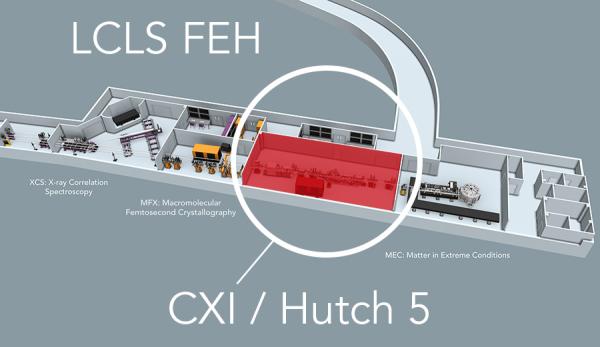CXI (Coherent X-ray Imaging)
The CXI instrument uses unique hard X-ray pulses in a vacuum sample environment to provide low background suitable for forward scattering experiments and weakly scattering systems
The CXI primarily uses the “diffraction-before-destruction” method, a technique to quickly acquire data with ultrashort pulses during measurement before the sample is destroyed. This benefits systems that suffer from electronic and structural damage during long-term exposures to X-rays.
Capabilities
A variety of tools and devices enable CXI to utilize X-ray emission spectroscopy, back-scattering, small and wide angle scattering, and ion and electron time of flight spectroscopy.
A flexible pump laser system is available for time-resolved experiments in the femtosecond time scale. Samples can be introduced to the X-ray beam either fixed on targets or in a liquid jet.
Experiments at atmospheric pressure are possible under certain limited circumstances. High quality Kirkpatrick-Baez focusing optics are available to generate three foci (10, 1 and 0.1 micron) in the 5-11keV range. Photon energies greater than 11keV can be used by focusing with compound refractive lenses to a focal size of >2 microns.
For more information about CXI instrument, please read the article:
Location
The CXI instrument is located in Hutch 5 of the Far Experimental Hall of LCLS. The hutch is 20 m long by 7 m wide and located 440 m away from the LCLS source.

Multimedia
For more CXI related videos, see the LCLS CXI playlist on YouTube.
CXI CONTACTS
Meng Liang
CXI Instrument Lead
(650) 926-2827
mliang@slac.stanford.edu
Matt Hayes
Area Manager
(650) 926-3060
hayes@slac.stanford.edu
Joe Robinson
Lead Laser Scientist
(650) 926-5190
jsrob@slac.stanford.edu
Michael Minitti
Senior Scientist
(650) 926-7427
minitti@slac.stanford.edu
Andy Aquila
Staff Scientist
(650) 926-2682
aquila@slac.stanford.edu
Xinxin Cheng
Staff Scientist
(650) 926-3156
xcheng@slac.stanford.edu
Sandra Mous
Staff Scientist
(650) 926-6225
smous@slac.stanford.edu
Kirk Larsen
Associate Laser Scientist
(650) 926-3728
larsenk@slac.stanford.edu
Philip Hart
Detectors Engineer
(650) 926-2813
philiph@slac.stanford.edu
Stella Lisova
Sample Delivery Engineer
(650) 926-3272
stellal@slac.stanford.edu
Divya Thanasekaran
Controls Engineer
(650) 926-8917
divya@slac.stanford.edu
Serge Guillet
Staff Engineer
(650) 926-4771
sguillet@slac.stanford.edu
CXI Control Room
(650) 926-6295
(650) 926-6296
(650) 926-6297
(650) 926-6298
CXI Hutch
(650) 926-6291


